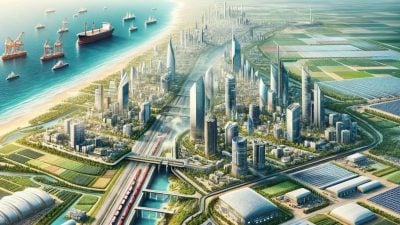Gaza 2035: Netanyahu Hatches Plan to Raze and Rebuild Enclave
Israeli businessmen close to the prime minister wish to turn a destroyed Gaza into a regional trade and industrial hub under Israeli control and exploiting Palestinian natural gas and cheap labor

All Global Research articles can be read in 51 languages by activating the Translate Website button below the author’s name (only available in desktop version).
To receive Global Research’s Daily Newsletter (selected articles), click here.
Click the share button above to email/forward this article to your friends and colleagues. Follow us on Instagram and Twitter and subscribe to our Telegram Channel. Feel free to repost and share widely Global Research articles.
Global Research Wants to Hear From You!
***
Documents published online lay out Israeli Prime Minister Benjamin Netanyahu’s post-war vision for the Gaza Strip, known as “Gaza 2035,” the Jerusalem Post reported on 3 May.
The plan involves keeping Gaza under long-term Israeli security control, making major investments to rebuild the devastated enclave “from nothing” with Gulf assistance, turning Gaza into a regional trade and energy hub, and exploiting cheap Palestinian labor and natural gas for the benefit of Israeli business interests.
The document refers to Gaza as an “Iranian outpost” that “sabotages emerging supply chains” while euphemistically claiming it “thwarts any future hope for the Palestinian people.”
According to the document, the plan involves three steps.
The first step is planned to last 12 months and will see Israel create “safe areas free of Hamas control” in Gaza, starting first in the north and moving to the south.
Gazan Palestinians will run the safe zones under the supervision of a coalition of Arab states, which would be responsible for providing humanitarian aid.
Step two would last five to ten years. The Israeli military will retain control of the strip, while the Arab states will be responsible for reconstruction under a newly established Gaza Rehabilitation Authority (GRA), and Palestinians will manage the safe areas.
Reconstruction efforts will involve “rebuilding from nothing” and designing new cities from scratch, featuring modern designs and planning. This implies that the Israeli military will continue to destroy much, if not all, of Gaza through bombing and controlled demolition.
Stage three would see Palestinians “self-govern” a demilitarized Gaza while Israel retains the right to act against “security threats.”
The final step, the Jerusalem Post notes, would be for the Palestinians to “fully manage Gaza independently” and join the Abraham Accords, an agreement binding several existing Arab states in an alliance with Israel.
The Jerusalem Post claims that the plan would benefit Palestinians in Gaza by offering them employment opportunities and eventual “self-governance” – under continued Israeli security control.
Many Israeli politicians have called for all of Gaza’s 2.3 million people to be forcibly expelled to Egypt or Europe. But the plan apparently calls for some to remain in Gaza as a source of cheap labor.
The Jerusalem Post says the plan would benefit the Gulf states by offering them “defensive pacts with the US and unfettered access to Gaza’s Mediterranean ports through railways and pipelines.”
The plan aims to turn Gaza into a significant industrial port on the Mediterranean, facilitating the export of Gazan goods, Saudi oil, and other raw materials from the Gulf.
The plan also calls for creating a massive free trade zone stretching from the Israeli city of Sderot through Gaza to Al-Arish on the Egyptian coast, which would benefit business interests in all three.
Israel would tap the natural gas fields off the coast of Gaza to provide the energy needed for industrial manufacturing. Israel has blocked the development of the fields, which legally belong to Palestinians, for decades.
The Jerusalem Post adds that the plan included a proposal to manufacture electric cars in the free trade zone and complete with “cheap Chinese manufacturing,” further suggesting cheap Palestinian labor from Gaza would be critical to the proposal.
Israeli business interests would likely benefit most. The New York Times (NYT) reported on 3 May that the plan for Gaza was drawn up in November by a “group of businessmen, most of them Israeli, some of whom are close to Mr Netanyahu.”
NYT added that the officials said the plan was “under consideration at the highest levels of Israel’s government.”
Any Israeli plan for post-war Gaza would also need to accommodate the demands of Israel’s far-right religious settler community, which demands colonizing Gaza and constructing Jewish settlements there after the war.
Housing and Construction Minister Yitzhak Goldknopf, head of the ultra-Orthodox United Torah Judaism party, released a video message on 14 May endorsing a protest march that demanded renewed Israeli settlement in the Gaza Strip.
“It is very important to identify with this march and afterwards to take part in the mass gathering in Sderot,” he says.
According to organizers, buses will bring participants from all over the country to the demonstration, which has also been endorsed by far-right Otzma Yehudit MK Limor Son Har-Melech.
Journalist Vanessa Beeley concluded that the “Gaza 2035” plan would indeed include the forcible expulsion of Palestinians and the building of Jewish settlements and that the plan was likely drawn up much earlier than acknowledged by NYT. She wrote,
“What is certain is that this plan has been in the Zionist/US pipeline for perhaps decades and is only now being put into effect with the exploitation of events of 7 October by Israel to secure the Nakba II in Gaza and to increase the Zionist footprint in what remains of Palestine in the occupied territories.”
*
Note to readers: Please click the share button above. Follow us on Instagram and Twitter and subscribe to our Telegram Channel. Feel free to repost and share widely Global Research articles.
Featured image: AI generated image of Gaza found in the PMO’s plan for a post-war Gaza, May 3, 2024. (Photo credit: Jerusalem Post)

